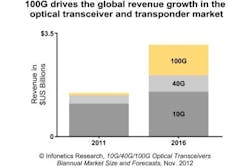Once the final numbers for 2012 are tallied, sales of optical transceivers and transponders will have risen 7% this year, believes market research firm Infonetics Research. Tunable transceivers and 100-Gbps transceivers will have set the pace, Infonetics analysts say. The news should continue to be good in 2013 as well, the company expects.
The announcement comes as Infonetics preps its 10G/40G/100G Optical Transceivers market size and forecast report, which tracks such devices sold for optical transport, enterprise, data center, and carrier routing and switching applications. The estimation is slightly more aggressive than that of LightCounting, which recently suggested the market will have grown 6% this year (see “LightCounting: 2012 'reasonably good' for optical transceiver vendors”).
The data suggests that the hype surrounding 100-Gbps technology was well founded. "100G continues to surpass even our most optimistic projections," reports Andrew Schmitt, principal analyst for optical at Infonetics Research. "There's been a flurry of prototyping, sampling, and trial activity all around the world, including China, where plans for 100G have been bumped up by 12 months since we spoke to operators there last spring. In line with our aggressive forecasts, worldwide shipments of 100G coherent transceivers more than tripled in 2012, and will at least double in 2013."
Many 100G transceiver shipments this year came from network equipment vendors, a trend Infonetics expects to continue for the foreseeable future. In fact, the company forecasts that systems houses will supply more than 75% of 100-Gbps long-reach ports by 2014-2015.
Combined sales value of 40-Gbps and 100-Gbps optical modules should equal that of 10-Gbps optical transceivers by 2015 as well, which further testifies to the shift toward high-speed fiber-optic networks (see figure below). Concurrently, revenues for 10G and 40G devices are being pressured by price declines and the growing popularity of 100G.
"The other big deal in the transceiver market is that the pricing gap collapsed between tunable and non-tunable XFP, further spurring adoption of tunable XFP technology," Schmitt adds.
The overall growth comes against backdrop of capex declines and macro-economic uncertainty. Nevertheless, Infonetics remains bullish on the optical transceiver/transponder niche, forecasting the space will see double-digit growth in 2013. That will place market value near $2 billion, Infonetics concludes.
For more information on transceivers/transponders and suppliers, visit the Lightwave Buyer’s Guide.

